2 东京大学地球与行星科学学院, 东京 113-8654;
3 台湾海洋大学海洋科学与资源学院, 台湾 基隆 20224;
4 云南大学地球系统科学研究中心, 云南 昆明 650504)
前人研究认为,东海内陆架泥质沉积物的主要来源为长江流域输送的悬浮颗粒物,其受“夏储冬输”的规律所控制,进入浅海随着闽浙沿岸流向南搬运,被台湾暖流阻挡于近岸地带沉积形成东海泥质条带[1~3],因此该区域泥质沉积物可记录长江流域古环境及古气候信息。与陆地湖泊、泥炭等记录相比,该记录可消除地形、局域物源等因素影响,同时该沉积物具有稳定的沉积速率且未受扰动,是研究沉积物源、源区气候环境变化的宝贵材料。目前,东海泥质区已开展大量的气候环境研究工作,如利用粒度或无机地球化学等参数,讨论物源、季风、泥质沉积物的沉积模式等[4~9]。但关于全新世陆源有机质输入、源区植被变化及其影响因素等方面的研究还较缺乏[10]。
全新世的气候变化幅度虽然不如末次冰期,但仍然是不稳定的[11]。全新世大暖期之后,研究区的气候发生了由暖湿到凉干的转型,并在千年及百年尺度上呈现次一级的波动和突变[12]。气候是影响陆地植被生长和分布的主要因素[13],如果全球气温上升超过3 ℃,44 %的陆地植被系统会受到影响[14]。全新世的气候变化则对我国热带-亚热带区域的植物群生存及繁衍产生了重要作用[15~16]。除气候因素以外,人类活动对区域植被也产生了重大的改变,如宁绍平原西端的跨湖桥先民在7000多年前进驻该区域后产生人进林退的现象,开始了水稻驯化等新的土地利用方式[17~18],对沼泽湿地上的灌乔木或湿地草本植物进行清理开荒。孢粉研究表明,长江中下游流域在中、晚全新世时期植被组成发生了较大的变化,常绿落叶阔叶林被耐冷的松林替代[16, 19~20],这可能是由于气候逐渐变冷及东亚夏季风减弱所致[22~23]。由于松属花粉具有超代表性,孢粉微体化石受局地植被、地形影响较大,从而这一研究结果还有待于其他指标的验证。此外,近千年来中国东部强烈的人为干扰也可能摧毁自然植被[24~25],并且也是由于这个原因,研究区陆相地层通常被扰动,测年较好的沉积序列较缺乏,因此反映古植被变化的研究成果相对较少且通常缺乏具体的年代框架[10]。
近年来,有机分子化石正构烷烃类化合物得到广泛的研究,已成为过去全球变化研究极具潜力的代用指标。该类化合物在地质时期较为稳定,可在沉积物中广泛存在,能相对真实地反映原始母质生源及气候环境信息。其中,长链正构烷烃(以下简称正构烷烃)主要由陆地高等植物叶蜡产生[26],经河流或风尘搬运至海洋能够稳定沉积保存,已被广泛用于重建陆地上的古环境和古植被[27~33]。目前长江流域也开展了相关研究[34~36],但研究材料多为湖泊泥炭沉积物,受到局部环境影响较大[34~36],或未进行较好地定年[35],而东海的相关研究侧重于表层沉积物[37~38]。本研究拟通过对晚全新世以来东海泥质沉积序列的正构烷烃指标等有机地球化学记录的探讨,以揭示该区域约4400年来陆源有机质输入以及源区植被变化及其与气候、人类活动的关系。
1 材料与方法 1.1 研究材料2006年7月中法合作海洋科考船Maco-Polo Ⅱ在中国东海陆架泥质沉积区闽浙沿岸,通过沉箱式重力钻探法取得研究岩芯MD06-3039A (27°43.36′N,121°46.88′E;水深47 m;位置见图 1)。MD06-3039A全长8.11 m,主要由灰色到灰黄色泥质粉砂组成,仅在300~333 cm发现明显的岩性突变;此外,观察岩芯还可见一些小型贝类碎片和有孔虫壳体残余。对MD06-3039A进行薄层取样,共采集分析91个样品,其中顶部1 m按5 cm间隔取样共计21个,剩余部分按10 cm间隔取样共计70个。整个岩芯的样品平均分辨率约为50 a/样。
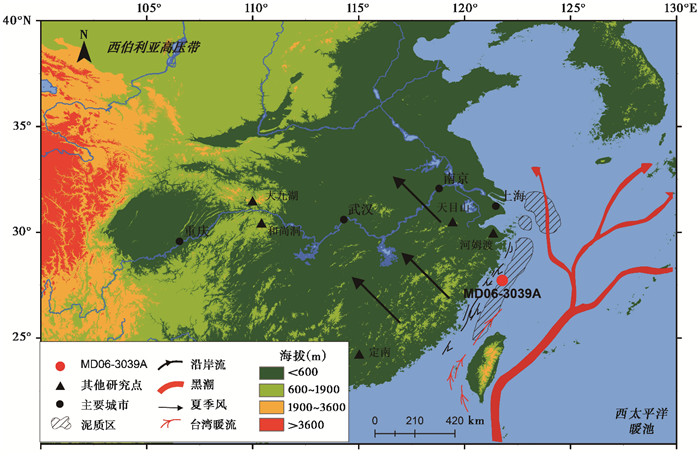
|
图 1 MD06-3039A孔地理位置及周边地形环境示意图 在东亚季风夏季风(EASM)和东亚冬季风(EAWM)的影响下,以及中国沿岸流(CCC)、黑潮(KC)及其支流台湾暖流(TWC)的共同作用下,由长江搬运来的陆源碎屑物质在中国东海陆架沉积并形成了条带分布的东海泥质区;图中红色点为本研究钻孔MD06-3039A,黑色三角指示研究区内其他相关研究点地理位置 Fig. 1 Location of core MD06-3039A and geographic view of the study area. Under the influence of the East Asian Summer Monsoon(EASM)and the East Asian Winter Monsoon(EAWM), together with the effects of China Coastal Current(CCC), Kuroshio(KC)and its subsidiary Taiwan Warm Current(TWC), the terrestrial clastic material has been transported mainly from the Yangtze River to the inner continental shelf of the East China Sea and forms a widely distributed muddy area. The red spot represents the core MD06-3039A, and the black triangle indicates the location of other relevant study sites |
正构烷烃分析前处理流程:称取约5 g研磨至150目的干样,置于离心管,加入约15 ml二氯甲烷(DCM)-甲醇(MeOH)混合溶剂(v:v=3:1),与此同时,加入30 μL已知浓度C24D烷烃作为内标,超声抽提15 min后离心分离(转速为2000 r/min,离心时间10 min),收集上层清液(即为萃取物Total Lipid Content,简称为TLC),此超声萃取过程重复4次;TLC在纯N2环境吹干后用适量正已烷多次转移至活化过的硅胶柱内,并用正己烷淋洗得到烷烃组分,然后用柔和N2吹干定容待测。正构烷烃组分的测试参数为:石英毛细管HP-1 (50 m×0.32 mm×0.17 μm),不分流进样,进样口温度为300 ℃,色谱柱升温程序如下:初始温度为70 ℃,保持1 min,然后以10 ℃/min升温到210 ℃,再以3 ℃/min升温到310 ℃,保持25 min。测试前用正己烷溶解样品并定容,进样量1 μL。根据目标化合物峰面积和C24D的峰面积比值来换算其相对于沉积物的含量。
1.3 年代框架及沉积速率MD06-3039A孔沉积序列的年代模型是利用该孔沉积物中贝壳样品加速质谱14C年龄(AMS 14C)建立的,AMS 14C前处理工作在中国科学院广州地球化学研究所完成,分析测试工作在北京大学核物理与核技术国家重点实验室完成,MD06-3039A孔的原始年龄数据及经Cailb 7.0校正[39~40]后得到的日历年龄如表 1所示。本次研究共对5个样品进行了AMS 14C分析,并通过内插和外插法获得各样品的年代。如图 2所示,该沉积岩芯顶部为现代沉积物,底部8.11 m其年代约为4400 cal.a B. P.。
| 表 1 MD06-3039A孔岩芯样品AMS 14C年代 Table 1 AMS14C ages of core MD06-3039A |
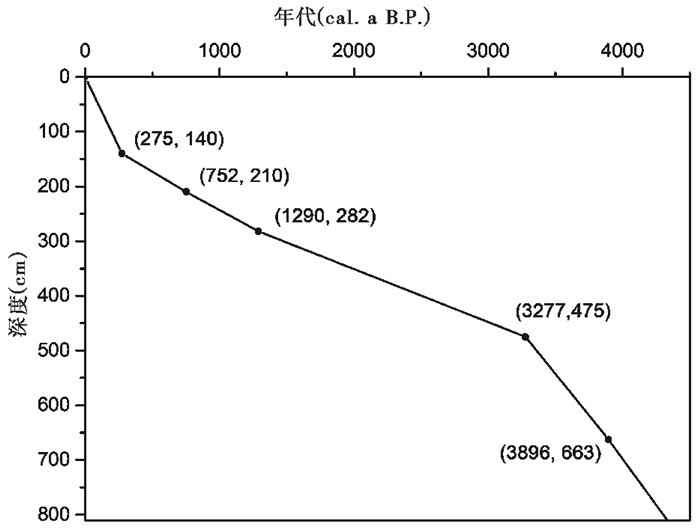
|
图 2 MD06-3039A岩芯AMS 14C年代-深度序列 Fig. 2 The AMS 14C age-depth sequence of core MD06-3039A |
根据年代-深度序列计算MD06-3039A孔的沉积速率,4400年以来平均值为1.7 mm/a,变化范围为1.0~5.1 mm/a。其中,4400~3200 cal.a B. P.、3200~1300 cal.a B. P.和1300~0 cal.a B. P.期间的沉积速率分别为3.0 mm/a、1.2 mm/a和3.3 mm/a;此外,约300 cal.a B. P.以来沉积速率迅速增加,达5.1 mm/a。
2 数据分析 2.1 沉积物正构烷烃分布特征MD06-3039A岩芯样品正构烷烃的分布范围为nC15~nC35,以长链奇数烷烃为主,多数样品呈现单峰型分布,如图 3a和3c所示,主碳峰为nC3l,且具有明显的奇偶优势(odd-even predominance,简称为OEP,其计算公式为OEP=2×nC29/(nC28+nC30)[41])。极少数样品主碳峰呈现双峰型,包括分布范围为nC17~nC21的短碳链烃类,以及nC27~nC33长链奇数烷烃类(如图 3b所示)。图 3为沉积序列上、中、下部位深度分别为140 cm(编号A140),379 cm(编号A379)和600 cm(编号A600)样品的正构烷烃分布图,这3个代表性样品长链奇数烷烃占总烷烃量平均达到了约72.0 %,是中短链数烷烃百分比的3.5~2.0倍,他们的OEP值分别为4.97、4.07和4.44。

|
图 3 MD06-3039A钻孔3个不同深度样品正构烷烃分布情况 圆饼图给出了各样品长、中、短链烷烃含量比值,各样品OEP值表明奇偶优势明显 Fig. 3 Distribution of n-alkanes of core MD06-3039A in 3 different depth. The pie chart shows the ratio of alkane content in the long, medium and short chain for each sample, and the OEP values of all three samples show that the odd-even predominance is obvious |
本研究采用的正构烷烃参数主要包括有:长链奇数烷烃总量(计算式为ΣnC27~33);短链奇数烷烃总量(计算式为ΣnC17~21);长链烷烃/中-短链烷烃的比值[42](简写为LCA/MSCA,其计算式为ΣnC27~33/ΣnC17~25);正构烷烃奇偶优势OEP;长链正构烷烃平均链长ACL(Average Carbon Length,ACL=ΣCi×[Ci]/Σ[Ci],[Ci]代表碳数在27~33以内碳数为i的正构烷烃的含量[43]);以及nC31/nC27等。如图 4a、4b和4c所示,正构烷烃含量指标呈现出了三段式波动变化,即4400~3200 cal.a B. P.和1300~0 cal.a B. P.阶段相对较高,3200~1300 cal.a B. P.相对较低。
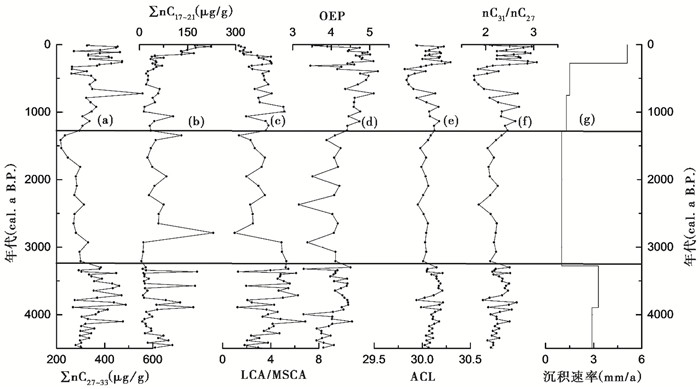
|
图 4 MD06-3039A孔沉积物烷烃指标变化曲线 (a)长链奇数正构烷烃总量变化曲线;(b)短链奇数正构烷烃总量变化曲线;(c)LCA/SMCA;(d)OEP变化曲线;(e)正构烷烃平均链长ACL变化曲线;(f)nC31/nC27比值变化曲线;(g)MD06-3039A沉积速率变化曲线 Fig. 4 Variation of n-alkane indices of core MD06-3039A. (a)The curve for total content of long-chain odd-number alkanes; (b)The curve for total content of short-chain odd-number alkanes; (c)The curve of LCA/SMCA; (d)The curve of OEP; (e)The average chain length of n-alkanes (ACL curve); (f)The curve of nC31/nC27 changes; (g)The deposition rate curve |
该岩芯OEP平均值为4.2,变化范围为2.6~5.2。从图 4d中可以发现,该曲线在3200 cal.a B. P.时出现了明显的下降并在之后一直保持较低水平,到约1300 cal.a B. P.才又开始升高。3200 cal.a B. P.之前OEP平均值为4.0而3200~1300 cal.a B. P.时期OEP平均值略有降低为3.9,1300~0 cal.a B. P.时期OEP平均值升高到4.6。
如图 4e和4f所示,ACL、nC31/nC27的变化趋势与其他指标一致,呈现3个阶段波动变化。3200 cal.a B. P.之前ACL和nC31/nC27平均值分别为30.11和2.30,而3200~1300 cal.a B. P.时期它们的平均值分别降低至30.03和2.10在1300~0 cal.a B. P.时期ACL和nC31/nC27平均值分别为30.06和2.40。此外,在312~0 cal.a B. P.时段为极大值时期,ACL的平均大小为30.12,变化范围为29.94~30.29,nC31/nC27的平均值为2.56,变化范围1.97~3.06。
3 讨论 3.1 东海泥质区MD06-3039A孔物源输入变化及其影响因素正构烷烃短链奇数烷烃(nC17~nC21)主要来源于等海洋低等生物的类脂物(如藻类浮游生物和细菌输入),长链奇数烷烃(nC27~nC33)主要来源于陆源高等植物[44],虽然浮游生物的藻类和细菌的改造作用都可以产生长链烷烃类,但这些烷烃分布没有明显的奇偶优势(即OEP约等于1)[45]。从本次正构烷烃研究的结果来看,MD06-3039A孔岩芯的OEP值远大于1,表明长链正构烷烃来自低等生物改造作用产生的较少,而主要来源于陆地高等植物的输入。MD06-3039A孔整个序列中,长链烷烃与中-短链烷烃总量的比值(LCA/SMCA)被用来指示沉积物中内外源有机质输入的相对变化,该值变化范围为1.0~6.8,平均值为3.4,这表明该区域有机质输入具有明显的陆源特征,来源为高等植物的正构烷烃对沉积有机质的贡献较大,而微生物和菌藻类的输入量对沉积有机质的贡献较小[28]。
东海沉积陆源输入主要有如下几个:长江、古黄河沉积、钱塘江、瓯江和闽江以及台湾西部河流等[46]。台湾西部河流物质部分细颗粒物向东北运移进入冲绳海槽,其影响浙闽沿岸泥质区的北部边界在26°N以南[5, 47],而古黄河沉积,主要分布于32°N以北、台湾暖流以东的海域[2],对MD06-3039A孔所在区域均无影响。钱塘江、瓯江和闽江等,由于泥沙亏缺,接纳长江入海悬沙补给或海域补给,对东海内陆架泥质区影响也甚小[48]。因此,从流域体系上来分析,浙闽沿岸泥质区的物质来源主要来自长江输入。此外,前人对该泥质沉积进行了粒度[6]、常量、微量和稀土元素组成[49~50],矿物学和Sr-Nd同位素组成[9],及表层正构烷烃碳同位素组成[37~38]等地球化学指标分析,均认为该沉积体具有长江沉积物的特性。从正构烷烃分布模式来看,本研究沉积序列多数样品呈高碳数单峰型,且nC31比nC29含量略高。通过与沿海区域其他的沉积物正构烷烃组成特征对比(图 5)[37],发现MD06-3039A孔与现代长江口CX4孔沉积物正构烷烃构型最为相似,相关性最好(如表 2所示),支持本区域沉积物中有机陆源碎屑主要来自长江流域的论断[37]。
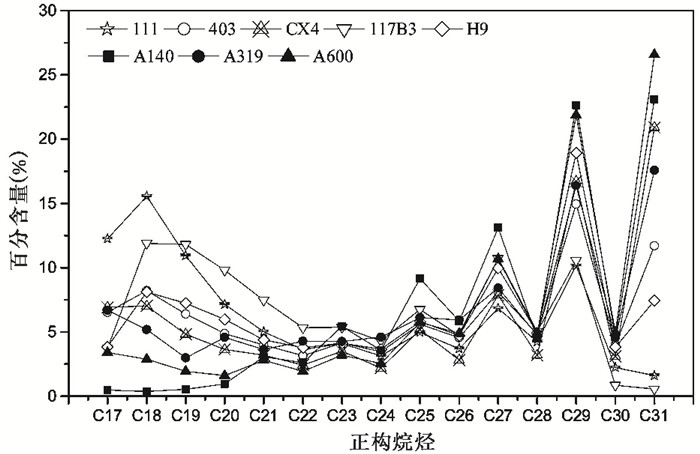
|
图 5 MD06-3039A孔典型样品与现代黄河口117B3孔、老黄河口H9孔、济州岛西南111孔、现代长江河口CX4孔、长江口泥质区403孔沉积物样品的正构烷烃分布组成对比分析[37] Fig. 5 Distribution of n-alkanes in different depths of core MD06-3039A compared to those in the modern sediments of the Yellow River(117B3), the Old Yellow River(H9), southwest of Jeju Island(111), the modern Yangtze River estuary(CX4), and the muddy area of the Yangtze River estuary(403)[37] |
| 表 2 MD06-3039A孔与东海周边区域其他沉积物[37]如117B3孔、H9孔、111孔、CX4孔、403孔沉积物样品之间正构烷烃分布模式的相关性 Table 2 Correlation of n-alkanes distribution pattern between core MD06-3039A with others cores[37] of 117B3, H9, 111, CX4, and 403 around China East China Sea[37] |
如图 4各正构烷烃指标曲线所示,该沉积区4400年以来陆源输入量呈现高—低—高三段式波动变化,且与该钻孔的沉积速率呈现较好的一致性。与此同时,海洋内生有机源输入、陆源/海源相对变化(LCA/SMCA值),基本呈现与陆源输入类似的变化,这暗示陆源与海洋内生源输入影响因素的相关性。研究表明,中、全新世以来,东海现代环流系统和季风气候可能是长江细粒沉积物向东海搬运和形成陆架泥质带的主要控制因素[9]。长江中下游区域石笋生长速率及氧同位素变化指示,3200~1300 cal.a B. P.时期长江流域中下游降雨较少[51],土壤侵蚀减弱,从而陆源输入量降低。邻近孔MD06-3040有孔虫氧同位素降低指示该阶段冬季风较强[52],较强冬季风会增大沿岸流强度,但此时极低的沉积速率表明,夏季风是东海地区河流入海颗粒物质搬运效率的主要影响因素。此外,该阶段低温、低盐和沿岸环境的浮游有孔虫G.bulloides丰度略有增加[52],但由于陆源输入少,营养盐低,总体上不利于海洋一些暖水优势藻类的生长[52],从而海洋内生源贡献比前后阶段有所降低。1300 cal.a B.P.以来,陆源输入和沉积速率增高,而陆表温度总体上持续下降[53],石笋生长速率及氧同位素显示该区域夏季风持续减弱[52],这暗示气候之外的人为因素对物源的影响,与长江流域此时段人类活动增强的相关记录相一致[25, 54~55]。人类活动增强会导致营养盐的增多,从而海洋生源输入也随之增加。
3.2 东海泥质沉积源区过去约4400年的植被、气候变化及人类活动中国东部现代植被的正构烷烃分布研究发现,无论木本植物、草本植物,其长链正构烷烃均主要以nC29或nC31为主峰[56],但从原文数据分析可以发现,nC31/nC27值在统计上仍具有与前人一致的指示意义[57~59],即nC31/nC27值增加,指示源区草本/木本植物相对增加,反之,指示源区草本/木本植物相对减少。MD06 - 3039A钻孔nC31/nC27值变化指示,在4400~3200 cal.a B. P.和1300~0 cal.a B.P.两阶段草本植物相对含量增多,而3200~1300 cal.a B. P.阶段木本植物相对增多,与前人孢粉结果可以比对。长江中下游流域在3200~1300 cal.a B. P.阶段常绿落叶阔叶林为主的森林群落被耐冷的松林替代[16, 20~21, 60],而针叶林下通常较常绿落叶阔叶林下草本生物量更少,从而该阶段为木本植物的相对增多。
正构烷烃参数OEP、ACL指标对植被变化也有指示作用[28, 59, 61]。如图 6所示,OEP、ACL与nC31/nC27类似地呈现三段式的变化,但变化模式有一些细微差别。如图 6a、6b和6c中粗黑线所示各参数的平均值,OEP和nC31/nC27较接近,三阶段呈现中、低、高值变化模式,而ACL呈现高、低、中值的变化模式。研究认为,OEP和ACL值除受控植被外,还受气候和物源等因素的影响[56~57, 62]。当温度升高时,沉积物中的正构烷烃奇偶优势会有所降低即OEP值减小,其原因是温度较高时沉积物中微生物的作用会加强,含量较高的长链奇碳烷烃会降解,此外,较强的微生物作用也可合成更多不具奇偶优势的正构烷烃[63~64]。因此,假定OEP/(nC31/nC27)的比值可去除植被变化的影响,则该比值从老至今的3个阶段呈现低、中、高的变化,即指示温度逐渐降低的变化。一般而言,气候凉爽湿润时,陆地植被倾向合成短链烷烃叶蜡,当气候干热时陆地植被更倾向于合成长链烷烃叶蜡以避免水分流失[65],因此当气候干旱时,正构烷烃ACL值会增大;与此同时,草本植物平均链长要大于木本植物的平均链长[58]。同理,假定ACL/(nC31/nC27)的比值去除了植被变化的影响,则该比值从老至今的3个阶段呈现中、高、低的变化,即指示气候干旱程度在3200~1300 cal.a B. P.阶段相对较干,但整体上变幅极小。从本钻孔3200~1300 cal.a B. P.阶段较低的沉积速率来看,支持长江流域夏季风减弱降雨量降低的论断[66],但由于该阶段温度降低,蒸发量相应减少,空气湿度可能并无大的变化。该区域孢粉函数转换研究发现,约3~1 ka B.P.阶段夏季降雨或/和湿度均有降低[21];而长江中游地区的大九湖泥炭沉积和清江和尚洞石笋4个古水文代用指标研究发现,在3.0~1.7 ka B.P.是属于湿润期,1.7~1.3 ka B.P.为干旱期[29~30]。由此可见,该区域水文变化恢复的研究结果差异性较大,这一方面可能是由于水文变化受局域的地理条件影响,另一方面,可能是由于不同指标的指示意义存在降雨或是有效湿度的区分。从nC31/nC27指标指示的木本/草本变化来看,当木本植物增多时,理论上气候更为冷湿,但由于东部地区降雨量相对充沛[21],气候的冷暖因素可能对植被类型的变化影响更大,如气候变冷后阔叶林向针叶林的转变[21]。除此以外,气候的冷暖因素对植被的次一级波动变化仍有控制作用,本研究正构烷烃参数指示隋唐大暖期草本增多,明清小冰期早期木本增多。
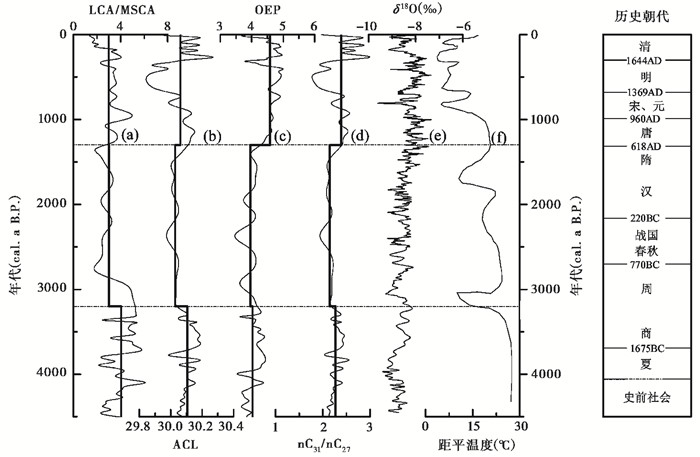
|
图 6 过去4400年MD06-3039A岩芯序列的物源、植被、气候变化指示与其他气候环境指标的对比 (a)长链/中、短链正构烷烃比值曲线;(b)ACL变化曲线;(c)OEP变化曲线;(d)nC31/nC27变化曲线;(e)清江和尚洞石笋氧同位素变化曲线[51];(f)物候学方法恢复的中国东部古温度变化曲线[53] Fig. 6 The changes of provenance, vegetation and climate information from sequence of core MD06-3039A compared with other climate and environmental proxies in the past 4400 years. (a)Ration of long chain n-alkanes/medium and short chain n-alkanes; (b)The average chain length; (c)The OEP; (d)nC31/nC27; (e)Heshang cave stalagmite oxygen isotope[51]; (f)Terrestrial temperature changes indicated by phenological method[53] |
如图 6e和6f所示,1300 cal.a B. P.以来该区域温度持续降低,湿度有所增加,但此阶段总体上草本植物较前两个阶段均增多,这表明除气候因素之外人类活动对植被变化的影响不可忽略。研究表明,该区域1.3 ka以来孢粉相发生明显改变,此时松属花粉减少,禾本科花粉急剧增加[21, 67],十字花科草本植物大量出现[68]。近300年以来,草本植物大大增多,印证人类活动加剧与气候变暖的双重影响。
4 结论本文通过对东海内陆架泥质沉积序列MD06-3039A岩芯共91个样品的有机地球化学记录如正构烷烃分布及正构烷烃参数的分析,研究了过去约4400年以来泥质区沉积物源变化、源区陆地植被变化及其气候与人类活动影响,获得以下一些认识。
(1) 东海泥质区4400年以来沉积有机质具有明显的陆源高等植物输入特征,物源输入呈现三阶段式波动变化,其中3200~1300 cal.a B. P.陆源输入减少,海洋性有机质输入亦略有降低,研究认为该时段长江流域夏季风减弱,降雨量偏少,土壤侵蚀弱,从而陆源输入量降低,并进一步导致输送入海的营养盐降低,不利于海洋一些优势藻类的生长。由此推断,夏季风是影响东海地区有机碎屑输入变化的主要因素。
(2) 以3200 cal.a B. P.和1300 cal.a B. P.为时间节点,正构烷烃参数nC31/nC27等指标指示该区域植被呈现3个阶段的波动变化,早期和晚期草本植物相对增多,中期木本植物相对增多的变化;但植被变化呈现次一级的波动,如隋唐大暖期草本增多,明清小冰期早期木本增多。在降水较充沛的中国东部区域,植被类型变化可能对温度的响应更明显。
(3) 1300 cal.a B. P.以来气候总体上继续凉干,但草本植物大量增多,表明该时段以来人类活动土地利用方式的变化导致植被类型发生了变化。
(4) 近300年以来,草本植物大大增多,印证人类活动加剧与气候变暖的双重影响。
致谢: 此研究开展及成文过程中,受David Taylor、Kajita、杨守业、卢粤晗、马春梅、盛雪芬等人的帮助,在此深表谢意;感谢审稿专家和编辑部杨美芳老师建设性的修改意见。
| [1] |
Milliman J D, Shen H T, Yang Z S, et al. Transport and deposition of river sediment in the Changjiang estuary and adjacent continental shelf[J]. Continental Shelf Research, 1985, 4(1): 37-45. |
| [2] |
范德江, 杨作升, 孙效功, 等. 东海陆架北部长江、黄河沉积物影响范围的定量估算[J]. 中国海洋大学学报(自然科学版), 2002, 32(5): 748-756. Fan Dejiang, Yang Zuosheng, Sun Xiaogong, et al. Quantitative evaluation of sediment provenance on the north area of the East China Sea shelf[J]. Journal of Ocean University of Qingdao (Natural Science), 2002, 32(5): 748-756. |
| [3] |
Liu J P, Li A C, Xu K H, et al. Sedimentary features of the Yangtze River-derived along-shelf clinoform deposit in the East China Sea[J]. Continental Shelf Research, 2006, 26(17): 2141-2156. |
| [4] |
王可, 郑洪波, Prins Maarten, 等. 东海内陆架泥质沉积反映的古环境演化[J]. 海洋地质与第四纪地质, 2008, 28(4): 1-10. Wang Ke, Zheng Hongbo, Prins Maarten, et al. High-resolution paleoenvironmental record of the mud sediments of the East China Sea inner shelf[J]. Marine Geology & Quaternary Geology, 2008, 28(4): 1-10. |
| [5] |
徐方建, 李安春, 李铁刚, 等. 中全新世以来东海内陆架泥质沉积物来源[J]. 中国石油大学学报(自然科学版), 2011, 35(1): 1-6. Xu Fangjian, Li Anchun, Li Tiegang, et al. Provenance of mud sediments in the inner shelf of East China Sea since mid-Holocene[J]. Journal of China University of Petroleum(Edition of Natural Science), 2011, 35(1): 1-6. DOI:10.3969/j.issn.1673-5005.2011.01.001 |
| [6] |
Wang K, Zheng H B, Tada R, et al. Millennial-scale East Asian Summer Monsoon variability recorded in grain size and provenance of mud belt sediments on the inner shelf of the East China Sea during mid-to Late Holocene[J]. Quaternary International, 2014, 349: 79-89. DOI:10.1016/j.quaint.2014.09.014 |
| [7] |
石学法, 刘升发, 乔淑卿, 等. 中国东部近海沉积物地球化学:分布特征、控制因素与古气候记录[J]. 矿物岩石地球化学通报, 2015, 34(5): 885-894. Shi Xuefa, Liu Shengfa, Qiao Shuqing, et al. Geochemical characteristics, controlling factor and record of paleoclimate in sediments from eastern China seas[J]. Bulletin of Mineralogy, Petrology and Geochemistry, 2015, 34(5): 885-894. |
| [8] |
肖尚斌, 李安春, 陈木宏, 等. 近8 ka东亚冬季风变化的东海内陆架泥质沉积记录[J]. 地球科学——中国地质大学学报, 2005, 30(5): 573-581. Xiao Shangbin, Li Anchun, Chen Muhong, et al. Recent 8 ka mud records of the East Asian winter monsoon from the inner shelf of the East China Sea[J]. Earth Science-Journal of China University of Geosciences, 2005, 30(5): 573-581. |
| [9] |
Bi L, Yang S, Zhao Y, et al. Provenance study of the Holocene sediments in the Changjiang (Yangtze River) estuary and inner shelf of the East China Sea[J]. Quaternary International, 2017, 441(Part A): 147-161. |
| [10] |
张玉兰, 范代读. 东海北部陆缘地区全新世孢粉组合及其古环境演变[J]. 海洋学研究, 2008, 26(1): 38-44. Zhang Yulan, Fan Daidu. Palanological assemblages and Holocene palaeoenvironmental evolution in the continental margin of the northern East China Sea[J]. Journal of Marine Sciences, 2008, 26(1): 38-44. DOI:10.3969/j.issn.1001-909X.2008.01.006 |
| [11] |
Mayewski P A, Rohling E E, Stager J C, et al. Holocene climate variability[J]. Quaternary Research, 2004, 62(3): 243-255. DOI:10.1016/j.yqres.2004.07.001 |
| [12] |
葛全胜, 王顺兵, 郑景云. 过去5000年中国气温变化序列重建[J]. 自然科学进展, 2006, 16(6): 689-696. Ge Quansheng, Wang Shunbing, Zheng Jingyun, et al. Reconstruction of temperature series in China for the last 5000 years[J]. Progress in Natural Science, 2006, 16(6): 689-696. DOI:10.3321/j.issn:1002-008X.2006.06.008 |
| [13] |
Seddon A W, Macias-Fauria M, Long P R, et al. Sensitivity of global terrestrial ecosystems to climate variability[J]. Nature, 2016, 531(7593): 229-232. DOI:10.1038/nature16986 |
| [14] |
Scholze M, Knorr W, Arnell N W, et al. A climate-change risk analysis for world ecosystems[J]. Proceedings of the National Academy of Sciences of the United States of America, 2006, 103(35): 13116-13120. DOI:10.1073/pnas.0601816103 |
| [15] |
Okuda M, Sato Y, Tang L H, et al. Late Holocene vegetation and environment at Cauduntou, west of Yangtze delta, SW Jiangsu Province, East China[J]. Quaternary International, 2003, 105(1): 39-47. DOI:10.1016/S1040-6182(02)00149-0 |
| [16] |
Zhao Y, Yu Z, Chen F, et al. Vegetation response to Holocene climate change in monsoon-influenced region of China[J]. Earth-Science Reviews, 2009, 97(1-4): 242-256. DOI:10.1016/j.earscirev.2009.10.007 |
| [17] |
Shu J W, Wang W M, Jiang L P. Did alder(Alnus) fires trigger rice cultivation in the lower reaches of the Yangtze River, East China?[J]. Palaeoworld, 2012, 21(1): 69-73. DOI:10.1016/j.palwor.2012.02.003 |
| [18] |
Zong Y, Chen Z, Innes J B, et al. Fire and flood management of coastal swamp enabled first rice paddy cultivation in East China[J]. Nature, 2007, 449(7161): 459-462. DOI:10.1038/nature06135 |
| [19] |
Wang S Y, Lü H Y, Liu J Q, et al. The Early Holocene Optimum inferred from a high-resolution pollen record of Huguangyan Maar Lake in Southern China[J]. Chinese Science Bulletin, 2007, 52(20): 2829-2836. DOI:10.1007/s11434-007-0419-2 |
| [20] |
Chen W, Wang W M, Dai X R. Holocene vegetation history with implications of human impact in the Lake Chaohu area, Anhui Province, East China[J]. Vegetation History & Archaeobotany, 2009, 18(2): 137-146. |
| [21] |
Lu F, Ma C, Zhu C, et al. Variability of East Asian summer monsoon precipitation during the Holocene and possible forcing mechanisms[J]. Climate Dynamics, 2018. DOI:10.1007/s00382-018-4175-6 |
| [22] |
Wang Y, Cheng H, Edwards R L, et al. The Holocene Asian monsoon:Links to solar changes and North Atlantic climate[J]. Science, 2005, 308(5723): 854-857. DOI:10.1126/science.1106296 |
| [23] |
Marcott S A, Shakun J D, Clark P U, et al. A reconstruction of regional and global temperature for the past 11, 300 years[J]. Science, 2013, 339(6124): 1198-1201. DOI:10.1126/science.1228026 |
| [24] |
Cao X, Xu Q, Jing Z, et al. Holocene climate change and human impacts implied from the pollen records in Anyang, Central China[J]. Quaternary International, 2010, 227(1): 3-9. DOI:10.1016/j.quaint.2010.03.019 |
| [25] |
Li J, Zhao Y, Xu Q, et al. Human influence as a potential source of bias in pollen-based quantitative climate reconstructions[J]. Quaternary Science Reviews, 2014, 99(99): 112-121. |
| [26] |
Eglinton G, Hamilton R J. Leaf epicuticular waxes[J]. Science, 1967, 156(3780): 1322-1335. DOI:10.1126/science.156.3780.1322 |
| [27] |
Zhou W, Xie S, Meyers P A, et al. Reconstruction of Late Glacial and Holocene climate evolution in Southern China from geolipids and pollen in the Dingnan peat sequence[J]. Organic Geochemistry, 2005, 36(9): 1272-1284. DOI:10.1016/j.orggeochem.2005.04.005 |
| [28] |
Zhou B, Zheng H, Yang W, et al. Climate and vegetation variations since the LGM recorded by biomarkers from a sediment core in the northern South China Sea[J]. Journal of Quaternary Science, 2012, 27(9): 948-955. DOI:10.1002/jqs.v27.9 |
| [29] |
Xie S, Evershed R P, Huang X, et al. Concordant monsoon-driven postglacial hydrological changes in peat and stalagmite records and their impacts on prehistoric cultures in Central China[J]. Geology, 2013, 41(8): 827-830. DOI:10.1130/G34318.1 |
| [30] |
Huang X, Xue J, Wang X, et al. Paleoclimate influence on early diagenesis of plant triterpenes in the Dajiuhu peatland, Central China[J]. Geochimica et Cosmochimica Acta, 2013, 123(1): 106-119. |
| [31] |
杨楚鹏, 刘芳, 常晓红, 等. 30 ka以来南海东北部陆坡坡底沉积有机质的长链正构烷烃特征及其古植被意义[J]. 第四纪研究, 2015, 35(4): 881-889. Yang Chupeng, Liu Fang, Chang Xiaohong, et al. The n-alkane records from sediments in the base of slope(near abyssal plain) of the north-eastern South China Sea (SCS) over the last 30 ka:Implications for paleovegetation[J]. Quaternary Sciences, 2015, 35(4): 881-889. |
| [32] |
刘晶晶, 张江勇, 陈云如, 等. 基于叶蜡正构烷烃重建的南海及周边地区植被类型[J]. 第四纪研究, 2016, 36(3): 553-563. Liu Jingjing, Zhang Jiangyong, Chen Yunru, et al. Vegetation changes recorded by leaf-wax n-alkanes around the South China Sea[J]. Quaternary Sciences, 2016, 36(3): 553-563. |
| [33] |
刘卫国, 王政, 李祥忠. 内源贡献对青海湖碳同位素指标量化的影响[J]. 第四纪研究, 2016, 36(3): 623-629. Liu Weiguo, Wang Zheng, Li Xiangzhong. The contribution of aquatic plants to sedimentary n-alkanes δ13C values using to qualify compositions of terrigenous plants in Lake Qinghai on the northeastern Qinghai-Tibetan Plateau[J]. Quaternary Sciences, 2016, 36(3): 623-629. |
| [34] |
He Y, Zhao C, Zheng Z, et al. Peatland evolution and associated environmental changes in Central China over the past 40, 000 years[J]. Quaternary Research, 2015, 84(2): 255-261. DOI:10.1016/j.yqres.2015.06.004 |
| [35] |
杨桂芳, 谢树成, 黄俊华, 等. 天目山泥炭类脂物记录的微生物特征和植被演替[J]. 地学前缘, 2008, 15(4): 170-177. Yang Guifang, Xie Shucheng, Huang Junhua, et al. Microbial characteristics and vegetation changes as recorded in lipid biomarker of Tianmushan peat bog[J]. Earth Science Frontiers, 2008, 15(4): 170-177. DOI:10.3321/j.issn:1005-2321.2008.04.019 |
| [36] |
Xue J, Li J, Dang X, et al. Paleohydrological changes over the last 4000 years in the middle and lower reaches of the Yangtze River:Evidence from particle size and n-alkanes from Longgan Lake[J]. The Holocene, 2017, 27(9): 1318-1324. DOI:10.1177/0959683616687386 |
| [37] |
郭志刚, 杨作升, 陈致林, 等. 东海陆架泥质区沉积有机质的物源分析[J]. 地球化学, 2001, 30(5): 416-424. Guo Zhigang, Yang Zuosheng, Chen Zhilin, et al. Source of sedimentary organic matter in the mud areas of the East China Sea shelf[J]. Geochimica, 2001, 30(5): 416-424. DOI:10.3321/j.issn:0379-1726.2001.05.002 |
| [38] |
朱纯, 潘建明, 卢冰, 等. 长江口及邻近海域现代沉积物中正构烷烃分子组合特征及其对有机碳运移分布的指示[J]. 海洋学报, 2005, 27(4): 59-67. Zhu Chun, Pan Janming, Lu Bing, et al. Compositional feature of n-alkanes in modern sediment from the Changjiang estuary and adjacent area and its implication to transport and distribution of organic carbon[J]. Acta Oceanologica Sinica, 2005, 27(4): 59-67. DOI:10.3321/j.issn:0253-4193.2005.04.008 |
| [39] |
Stuiver M. INTCAL 98 radiocarbon age calibration 24, 000 cal BP[J]. Radiocarbon, 1998, 40(3): 1041-1083. DOI:10.1017/S0033822200019123 |
| [40] |
Stuiver M, Reimer P J. Extended 14C database and revised CALIB radiocarbon calibration program[J]. Radiocarbon, 1993, 35(1): 215-230. DOI:10.1017/S0033822200013904 |
| [41] |
Scalan E S, Smith J E. An improved measure of the odd-even predominance in the normal alkanes of sediment extracts and petroleum[J]. Geochimica et Cosmochimica Acta, 1970, 34(5): 611-620. DOI:10.1016/0016-7037(70)90019-0 |
| [42] |
Ficken K J, Li B, Swain D L, et al. An n-alkane proxy for the sedimentary input of submerged/floating freshwater aquatic macrophytes[J]. Organic Geochemistry, 2000, 31(7): 745-749. |
| [43] |
Poynter J G, Farrimond P, Robinson N, et al. Aeolian-derived higher-plant lipids in the marine sedimentary record: Links with paleoclimate[M]//Leinen M, Sarnthein M. Palaeoclimatology and Palaeometeorology: Modern and Past Patterns of Global Atmosphere Transport. Dordrecht, The Netherlands: Kluwer Academic Publishers, 1989: 435-462.
|
| [44] |
周斌, 郑洪波, 杨文光, 等. 末次冰期以来南海北部沉积有机碳记录及其古植被环境信息[J]. 第四纪研究, 2011, 31(3): 498-505. Zhou Bin, Zheng Hongbo, Yang Wenguang, et al. Sedimentary organic carbon records in the northern South China Sea, implications for vegetation and environmental changes since the last glacial period[J]. Quaternary Sciences, 2011, 31(3): 498-505. DOI:10.3969/j.issn.1001-7410.2011.03.13 |
| [45] |
周斌, 郑洪波, 杨文光, 等. 末次冰期以来南海北部物源及古环境变化的有机地球化学记录[J]. 第四纪研究, 2008, 28(3): 407-413. Zhou Bin, Zheng Hongbo, Yang Wenguang, et al. Provenance and paleo-environment changes in the northern part of South China Sea since the last glacial period as recorded by organic geochemistry proxies[J]. Quaternary Sciences, 2008, 28(3): 407-413. DOI:10.3321/j.issn:1001-7410.2008.03.004 |
| [46] |
曹文红, 陈静, 马俊强. 大陆东南沿海河流与台湾西部河流磁性矿物特征及判源指标[J]. 第四纪研究, 2016, 36(1): 227-236. Cao Wenhong, Chen Jing, Ma Junqiang. Magnetic minerals as tracers for the mainland coastal rivers and west Taiwan rivers[J]. Quaternary Sciences, 2016, 36(1): 227-236. |
| [47] |
刘升发, 石学法, 刘焱光, 等. 中全新世以来东亚冬季风的东海内陆架泥质沉积记录[J]. 科学通报, 2010, 55(14): 1387-1396. Liu Shengfa, Shi Xuefa, Liu Yanguang, et al. Records of the East Asian winter monsoon from the mud area on the inner shelf of the East China Sea since the mid-Holocene[J]. Chinese Science Bulletin, 2010, 55(14): 1387-1396. |
| [48] |
肖尚斌, 李安春, 刘卫国, 等. 闽浙沿岸泥质沉积的物源分析[J]. 自然科学进展, 2009, 19(2): 185-191. Xiao Shangbin, Li Anchun, Liu Weiguo, et al. Provenance analysis of mud along the Min-Zhe Coast[J]. Progress in Natural Science, 2009, 19(2): 185-191. DOI:10.3321/j.issn:1002-008X.2009.02.009 |
| [49] |
郭志刚, 杨作升, 曲艳慧, 等. 东海陆架泥质区沉积地球化学比较研究[J]. 沉积学报, 2000, 18(2): 284-289. Guo Zhigang, Yang Zuosheng, Qu Yanhui, et al. Study on comparison sedimentary geochemistry of mud area on East China Sea continental shelf[J]. Acta Sedimentologica Sinica, 2000, 18(2): 284-289. DOI:10.3969/j.issn.1000-0550.2000.02.020 |
| [50] |
刘升发, 石学法, 刘焱光, 等. 东海内陆架泥质区表层沉积物常量元素地球化学及其地质意义[J]. 海洋科学进展, 2010, 28(1): 80-86. Liu Shengfa, Shi Xuefa, Liu Yanguang, et al. Geochemical characteristics and geological significance of major elements in the surface sediments from the inner shelf mud area of the East China Sea[J]. Advances in Marine Science, 2010, 28(1): 80-86. DOI:10.3969/j.issn.1671-6647.2010.01.011 |
| [51] |
Hu C, Henderson G M, Huang J, et al. Quantification of Holocene Asian monsoon rainfall from spatially separated cave records[J]. Earth and Planetary Science Letters, 2008, 266(3): 221-232. |
| [52] |
张在秀, 赵泉鸿, 陈荣华, 等. 东海泥质沉积区8千年来的有孔虫Mg/Ca和δ18O记录及其古环境意义[J]. 海洋地质与第四纪地质, 2010, 30(3): 79-86. Zhang Zaixiu, Zhao Quanhong, Chen Ronghua, et al. Foraminiferal Mg/Ca and δ18O records in the mud aera of the East China Sea during the last 8000 years and their palaeoenvironmental implications[J]. Marine Geology & Quaternary Geology, 2010, 30(3): 79-86. |
| [53] |
竺可桢. 中国近五千年来气候变迁的初步研究[J]. 考古学报, 1972, 2(1): 15-38. Zhu Kezhen. Preliminary study on climatic change during last five thousand years in China[J]. Acta Archeologica Sinica, 1972, 2(1): 15-38. |
| [54] |
Wang Z, Xu H, Zhan Q, et al. Lithological and palynological evidence of Late Quaternary depositional environments in the subaqueous Yangtze delta, China[J]. Quaternary Research, 2010, 73(3): 550-562. DOI:10.1016/j.yqres.2009.11.001 |
| [55] |
Huang K, Zheng Z, Liao W, et al. Reconstructing Late Holocene vegetation and fire histories in monsoonal region of Southeastern China[J]. Palaeogeography, Palaeoclimatology, Palaeoecology, 2014, 393(1): 102-110. |
| [56] |
Rao Z G, Zhu Z Y, Jia G D, et al. Compound-specific hydrogen isotopes of long-chain n-alkanes extracted from topsoil under a grassland ecosystem in Northern China[J]. Science China:Earth Sciences, 2011, 54(12): 1902-1911. DOI:10.1007/s11430-011-4252-8 |
| [57] |
Zhou B, Shen C D, Zheng H B, et al. Vegetation evolution on the central Chinese Loess Plateau since Late Quaternary evidenced by elemental carbon isotopic composition[J]. Chinese Science Bulletin, 2009, 54(12): 2082-2089. |
| [58] |
Cranwell A. Chain-length distribution of n-alkanes from lake sediments in relation to post-glacial environmental change[J]. Freshwater Biology, 1973, 3(3): 259-265. DOI:10.1111/fwb.1973.3.issue-3 |
| [59] |
He J, Jia G D, Li L, et al. Differential timing of C4 plant decline and grassland retreat during the penultimate deglaciation. Global and Planetary Change, 156: 26-33. http://www.sciencedirect.com/science/article/pii/S0921818116303526
|
| [60] |
舒军武, 王伟铭, 陈炜. 太湖平原西北部全新世以来植被与环境变化[J]. 微体古生物学报, 2007, 24(2): 210-221. Shu Junwu, Wang Weiming, Chen Wei. Holocene vegetation and environment changes in the NW Taihu plain, Jiangsu Province, East China[J]. Acta Micropalaeontologica Sinica, 2007, 24(2): 210-221. DOI:10.3969/j.issn.1000-0674.2007.02.007 |
| [61] |
Zhou W, Zheng Y, Meyers P A, et al. Postglacial climate-change record in biomarker lipid compositions of the Hani peat sequence, Northeastern China[J]. Earth and Planetary Science Letters, 2010, 294(1-2): 37-46. DOI:10.1016/j.epsl.2010.02.035 |
| [62] |
Wang M, Zhang W, Hou J. Is average chain length of plant lipids a potential proxy for vegetation, environment and climate changes?[J]. Biogeosciences Discussions, 2015, 12(12): 1-25. |
| [63] |
Grimalt J O, Torras E, Albaigés J. Bacterial reworking of sedimentary lipids during sample storage[J]. Organic Geochemistry, 1988, 13(4): 741-746. |
| [64] |
Xie S, Nott C J, Avsejs L A, et al. Molecular and isotopic stratigraphy in an ombrotrophic mire for paleoclimate reconstruction[J]. Geochimica et Cosmochimica Acta, 2004, 68(13): 2849-2862. DOI:10.1016/j.gca.2003.08.025 |
| [65] |
Gagosian R B, Peltzer E T. The importance of atmospheric input of terrestrial organic material to deep sea sediments[J]. Organic Geochemistry, 1986, 10(4): 661-669. |
| [66] |
Jiang T, Zhang Q, Zhu D, et al. Yangtze floods and droughts (China) and teleconnections with ENSO activities(1470-2003)[J]. Quaternary International, 2006, 144(1): 29-37. DOI:10.1016/j.quaint.2005.05.010 |
| [67] |
Yi S, Saito Y, Zhao Q, et al. Vegetation and climate changes in the Changjiang (Yangtze River) delta, China, during the past 13, 000 years inferred from pollen records[J]. Quaternary Science Reviews, 2003, 22(14): 1501-1519. DOI:10.1016/S0277-3791(03)00080-5 |
| [68] |
Wang Z, Hao X, Zhan Q, et al. Lithological and palynological evidence of Late Quaternary depositional environments in the subaqueous Yangtze delta, China[J]. Quaternary Research, 2010, 73(3): 550-562. DOI:10.1016/j.yqres.2009.11.001 |
2 Department of Earth and Planetary Science, Graduate school of Science, The University of Tokyo, Tokyo 113-8654;
3 School of Marine Science and Resources, Taiwan Ocean University, Jilong 20224, Taiwan;
4 Research Center for Earth System Science, Yunnan University, Kunming 650504, Yunnan)
Abstract
Continuous and relatively stable mud sediment depositions in the continental shelves of the East China Sea (ECS) provide high-quality archives for better understanding terrestrial climatic and environmental changes in the Holocene. However, few studies have focused on climatic and environmental reconstructions by the use of shelf sediments, in particular, to disentangle the complex interactions of the Asian monsoons, ocean currents, organic material inputs, and vegetation changes from the drainage areas of the Yangtze River into the ECS. In this study, organic geochemical indices of n-alkanes distribution patterns, and n-alkanes indices such as the ratio of long chain alkanes and medium-short chain alkanes (LCA/MSCA), Average Carbon Length (ACL), Odd-even predominance (OEP), and nC31/nC27 from an ECS core MD06-3039A are presented. The core MD06-3039A (27°43.36'N, 121°46.88'E; water depth of 47 m) was located at the mud belt off the Zhejiang-Fujian coast on the inner shelf of ECS, and drilled by a giant gravity corer during the IMAGES MD155-Marco Polo cruise Ⅱ by R/V Marion Dufresne in 2006. The total length of the core is 8.11 m, representing sediments deposited during the past 4400 years as indicated AMS14C dating. The averaged sedimentation rate of the core is 1.7 mm/a. The sediments are mainly composed of gray to gray yellowish silty silt with some small shellfish fragments and foraminifera shells visible in different depths. We have sampled 91 samples for this study and presented records here with an average resolution of approximately 50 years. Based on our analysis, the inputs of organic matter associated with terrestrial higher plants into the studied site have been decreased during a stage of 3200~1300 cal.a B.P., reflecting most likely the decreased summer precipitation in this region. In addition, the n-alkanes distributions indicate that the input of terrestrial organic matter is Yangtze River basin dominant. Furthermore, the indices of the n-alkanes suggest that the drainage area vegetation patterns have experienced fluctuations of three stages, with more herbaceous plants during the early and late stages and more woody plants during the middle stage of 3200~1300 cal.a B.P. Short-term fluctuations, such as the increases of herbaceous coincident with the Sui-Tang warm period and the increases of wood with the early Ming-Qing cold period are well-expressed in our records. Temperature change appears to be one of the most important effects in governing the change of grass/woody plants as inferred from our records. Our studies also suggest that since 1300 cal.a B.P., herbaceous plants have increased while the climate has been continuously cooler, implying anthropogenic changes in the land use patterns have been responsible for. During the past 300 years, the number of herbaceous plants has increased more rapidly, suggesting that the anthropogenic effects are accelerated. 2018, Vol.38
2018, Vol.38


